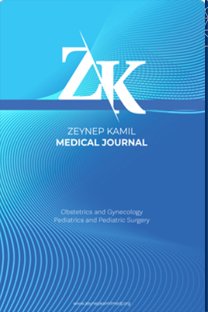Five years outcomes of hysteroscopy experience in a tertiary center
Five years outcomes of hysteroscopy experience in a tertiary center
___
- 1. Bonnamy L, Marret H, Perrotin F, Body G, Berger C, Lansac J. Sonohysterography: A prospective survey of results and complications in 81 patients. Eur J Obstet Gynecol Reprod Biol 2002;102(1):42–7.
- 2. Van Dongen H, De Kroon CD, Jacobi CE, Trimbos JB, Jansen FW. Diagnostic hysteroscopy in abnormal uterine bleeding: A systematic review and meta-analysis. BJOG An Int J Obstet Gynaecol 2007;114(6):664–75.
- 3. Bettocchi S, Nappi L, Ceci O, Selvaggi L. Office hysteroscopy. Obstet Gynecol Clin North Am 2004;31(3):641–54.
- 4. Pantaleoni DC. On endoscopic examination of the cavity of the womb. Med Press Circ 1869;8:26–7.
- 5. Vraneš HS, Djaković I, Kraljević Z, Radoš SN, Leniček T, Kuna K. Clinical value of transvaginal ultrasonography in comparison to hysteroscopy with histopathologic examination in diagnosing endometrial abnormalities. Acta Clin Croat 2019;58(2):249–54.
- 6. Bingol B, Gunenc Z, Gedikbasi A, Guner H, Tasdemir S, Tiras B. Comparison of diagnostic accuracy of saline infusion sonohysterography, transvaginal sonography and hysteroscopy. J Obstet Gynaecol 2011;31(1):54–8.
- 7. Serden SP. Diagnostic hysteroscopy to evaluate the cause of abnormal uterine bleeding. Obstet Gynecol Clin North Am 2000;27(2):277–86.
- 8. La Sala GB, Blasi I, Gallinelli A, Debbi C, Lopopolo G, Vinci V, et al. Diagnostic accuracy of sonohysterography and transvaginal sonography as compared with hysteroscopy and endometrial biopsy: A prospective study. Minerva Ginecol 2011;63(5):421-7.
- 9. El-Mazny A, Abou-Salem N, El-Sherbiny W, Saber W. Outpatient hysteroscopy: A routine investigation before assisted reproductive techniques? Fertil Steril 2011;95(1):272–6.
- 10. Zolghadri J, Momtahan M, Aminian K, Ghaffarpasand F, Tavana Z. The value of hysteroscopy in diagnosis of chronic endometritis in patients with unexplained recurrent spontaneous abortion. Eur J Obstet Gynecol Reprod Biol 2011;155(2):217–20.
- 11. Dendrinos S, Grigoriou O, Sakkas EG, Makrakis E, Creatsas G. Hysteroscopy in the evaluation of habitual abortions. Eur J Contracept Reprod Health Care 2008;13(2):198–200.
- 12. Koskas M, Mergui JL, Yazbeck C, Uzan S, Nizard J. Office hysteroscopy for ınfertility: A series of 557 consecutive cases. Obstet Gynecol Int 2010;2010:168096.
- 13. Lasmar RB, Barrozo PR, Parente RC, Lasmar BP, da Rosa DB, Penna IA, et al. Hysteroscopic evaluation in patients with infertility. Rev Bras Ginecol Obstet 2010;32(8):393–7.
- 14. Bartkowiak R, Kamiński P, Wielgoś M, Marianowski L. Accuracy of transvaginal sonography, sonohysterography and hysteroscopy in diagnosis of intrauterine pathology. Ginekol Pol 2003;74(3):203–9.
- 15. Nessar A, Nazik H, Murat HA. Salin infüzyon sonografisi ile ön tanı konulan hastaların histeroskopik tanılarının karşılaştırılması. Zeynep Kamil Tıp Bül 2014;45(1):1.
- 16. Cooper JM, Brady RM. Intraoperative and early postoperative complications of operative hysteroscopy. Obstet Gynecol Clin North Am 2000;27(2):347–66.
- 17. Istre O. Managing bleeding, fluid absorption and uterine perforation at hysteroscopy. Best Pract Res Clin Obstet Gynaecol 2009;23(5):619–29.
- 18. Yücel B, Demirel E, Kelekci S, Shawki O. Hysteroscopic evaluation of tubal peristaltic dysfunction in unexplained infertility. J Obstet Gynaecol 2018;38(4):511–5.
- 19. Promberger R, Simek IM, Nouri K, Obermaier K, Kurz C, Ott J. Accuracy of tubal patency assessment in diagnostic hysteroscopy compared with laparoscopy in ınfertile women: A retrospective cohort study. J Minim Invasive Gynecol 2018;25(5):794–9.
- 20. Gkrozou F, Koliopoulos G, Vrekoussis T, Valasoulis G, Lavasidis L, Navrozoglou I, et al. A systematic review and meta-analysis of randomized studies comparing misoprostol versus placebo for cervical ripening prior to hysteroscopy. Eur J Obstet Gynecol Reprod Biol 2011;158(1):17–23.
- 21. Selk A, Kroft J. Misoprostol in operative hysteroscopy: A systematic review and meta-analysis. Obstet Gynecol 2011;118(4):941–9.
- ISSN: 1300-7971
- Yayın Aralığı: Yılda 4 Sayı
- Yayıncı: Ali Cangül
Report of a pregnant woman with mosaic Turner syndrome
Yunus Emre TOPDAĞI, Ali İrfan GÜZEL, Emsal Pınar TOPDAĞI YILMAZ, Seray KAYA TOPDAĞ
Validity and reliability of the Turkish version of the Birth Experiences Questionnaire
Fadime BAYRI BİNGÖL, Meltem DEMİRGÖZ BAL, Melike DİŞSİZ, Sümeyye TOKAT, Melek IŞIK
Handan HAKYEMEZ TOPTAN, Sabiha PAKTUNA KESKİN
Prenatal diagnosis and management of hypoplastic left heart syndrome: Single center results
Gürcan TÜRKYILMAZ, Yunus Emre PURUT
Dudak ve/veya damak yarığı olan bebeklerde beslenme problemlerine yaklaşım
Osman Enver AYDIN, Ayla Gülden PEKCAN, Abdullah Barış AKCAN, Fatih SIRIKEN, Arif Aktuğ ERTEKİN, Ender CEYLAN
Recurrent pericarditis caused by familial Mediterranean fever: A case report
Masum KAYAPINAR, Gökalp ŞENOL, Gökhan ÜNVER, Zafer BÜTÜN, Kamuran SUMAN
Hasan TURAN, Zafer BÜTÜN, Ebru ÇÖĞENDEZ, Sinan ERDOĞAN, Erdal KAYA
Five years outcomes of hysteroscopy experience in a tertiary center
Burak SEZGİN, Ercan SARUHAN, Eren AKBABA, Melike NUR AKIN
Yeliz DOĞAN MERİH, Dilek COŞKUNER POTUR, Gülten KARAHAN OKUROĞLU
